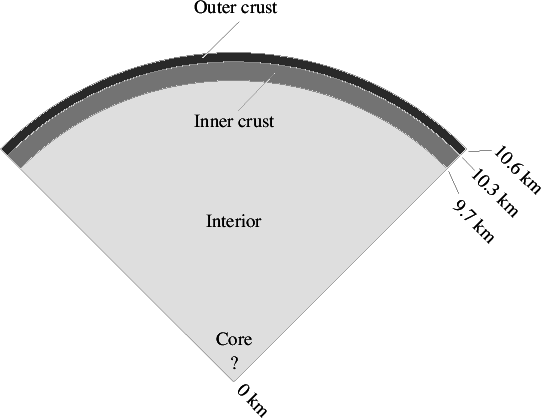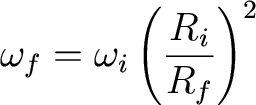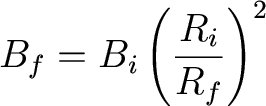Neutron Stars
So what do we get if the mass of the stellar core exceeds
the Chandrasekhar limit?
The core cannot be supported by electron degeneracy, and
collapse down until neutron degeneracy
takes over. Neutrons are fermions, and subject to the Pauli exclusion principle
just like electrons were.
How massive are neutron stars?
Typically, about 1.4 Msun, the Chandrasekhar mass. Why??
Because they are supported by (neutron) degeneracy, they
also follow a mass-radius relationship similar in behavior to that of white
dwarfs (R~M-1/3), but at much smaller sizes:
Also like white dwarfs, as a neutron star becomes more and
more massive, the neutrons become relativistic, and the equation of state
becomes that of a relativistic degenerate gas (of neutrons). So there is
a maximum mass of a neutron star (analagous to
the Chandrasekhar limit for white dwarfs) of about 3 Msun.
Past this? Black holes....
Structure of a neutron star
-
Outer crust: Iron and neutron rich nuclei, mixed with
relativistic degenerate electrons
-
Inner crust: Neutron rich nuclei, free superfluid
neutrons (from neutron drip), and relativistic
degenerate electrons
-
Interior: full of superfluid neutrons
-
Core: who knows? Pions?
|
 |
Properties of neutron stars
They spin - fast!
Conservation of angular momentum as the core
collapses:

Or, for a sphere of constant structure,

So the final spin frequency is

or the final spin period is

What is the initial rotation period? Not certain, but
for an example, let's use the rotation period of a nearby white dwarf:
1350 seconds. Then the rotation period of the neutron star will be PNS
~ 5x10-3 seconds!
They have very strong magnetic fields!
Magnetic flux (B times area) through the surface
of the core is also conserved in collapse. So

Which means that

Again, using the magnetic field strength of an extreme
white dwarf, B=5x108 Gauss, BNS ~ 1014
Gauss! Compare to the Sun, which has a magnetic field strength of 2 Gauss.
They are hot!
The temperature of their creation (in a supernova)
is 1011 K. They rapidly cool by neutrino emission down to a
temperature of 106 K (in a thousand years or so).
Stefan-Boltzmann: L = 4piR2sigmaT4
= 7x1032 erg/s. Like the Sun.
Easy to see? Nope: LambdaMax = 0.29/T ~ 29
Angstroms -- X-rays!
Hmm, tiny, X-ray emitting neutron stars. Could we ever see
them?





